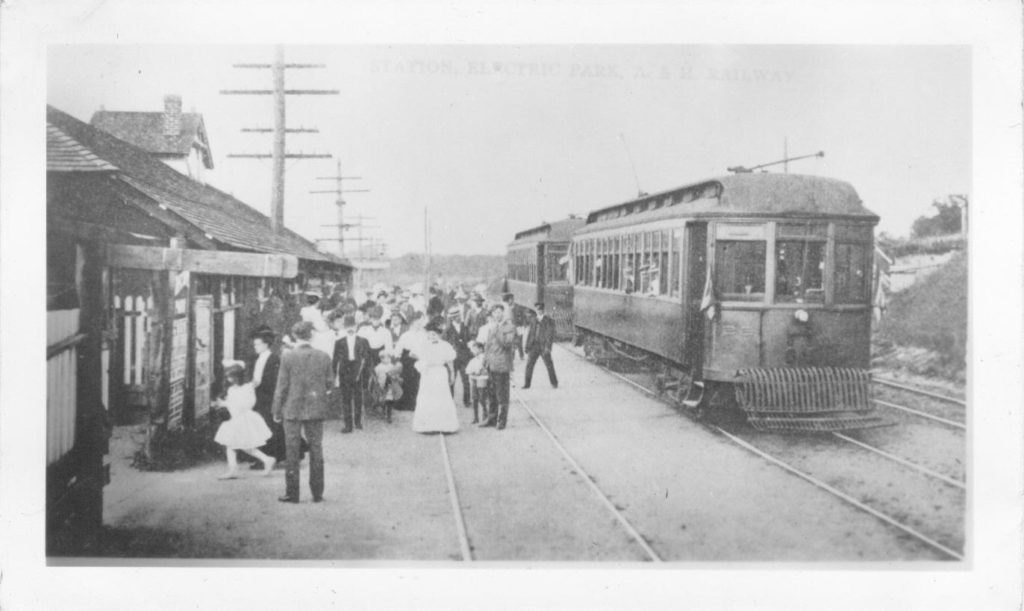
Remember when street railways also owned hydropower dams and provided electricity and gas service? Yeah, we never heard of that before, either. But turns out it happened, at least with one local streetcar company.
To get to the formation of the Albany and Hudson Railway and Power Company, which was incorporated in 1899 under the general Railroad Law, one has to do a railroad and electric company version of begats. First, the Citizens’ Electric Light and Power Company of Hudson and the Kinderhook Power and Light Company were merged into the Hudson Light and Power Company. Then, Hudson Light and Power was merged with the Hudson Street Railway Company, forming the Hudson Light & Power & Railroad Company, which was a real boon for local ampersand manufacturers. The Kinderhook and Hudson Railway was then merged into it, and then the HL&P&R and the Greenbush and Nassau Electric Railway were merged into the Albany and Hudson. All this took place over the course of a few months in 1899.
So this conglomerate came with a number of assets as well as good intentions. The Greenbush and Nassau Electric Railway had been chartered in 1897 to create a railway from Rensselaer to Niverville, but prior to the merger “a comparatively small amount of work had been done in the way of acquiring rights of way and grading the roadbed for an overhead trolley road.” They changed their plans to using a third rail in order to connect with the former Kinderhook and Hudson Railway, and had contracted to enter Albany and connect with its United Traction Company. “With the exception of the final work on the viaduct over the tracks of the New York Central and Hudson River and the Boston and Albany Railroads, near the city of Rensselaer, the entire road is now substantially completed. It is intended to run through cars from the connection with the United Traction Company, in the city of Albany, to the city of Hudson, operating by the overhead trolley in cities and with the third rail in other places.” Interestingly, the Albany and Hudson got a fair amount of its revenue (nearly half, in 1900) from sale of gas, electric light and power. The company’s directors and officers were all from New York City, and the company’s headquarters was 100 Broadway in the Big Apple. “In addition to its railroad properties the Albany and Hudson Railroad Company owns all the lighting plants, both gas and electric, in the cities of Hudson and Rensselaer, and also furnishes electric light and power to the villages of Kinderhook, Stuyvesant Falls, Nassau, East Greenbush, Niverville and Valatie.” But even that didn’t last long – the company went into receivership in 1902 and was acquired by the newly formed Albany and Hudson Railroad, not Railway, in early 1903, which was run by a different set of NYC people, also at 100 Broadway.
The Albany and Hudson Railroad Company continued for a few years; then, in 1909, it was reorganized again into the Albany Southern Railroad, which bought the Albany & Greenbush Bridge Co. That was the company that owned the Greenbush Bridge, which we’ve talked about before. It also supplied gas and electricity in the cities of Hudson and Rensselaer and electricity in Kinderhook, Nassau, Niverville, Schodack, Stuyvesant, North Chatham, Valatie and other communities along the east side of the Hudson River from Troy south to Hudson. They also supplied electricity to the Chatham Electric Light, Heat & Power Co., and the Wynantskill Hydro Electric Company. The electricity came from a hydro and steam plant at Stuyvesant Falls (4,000 kW in steam turbines, 3450 kW from water wheels). In 1921, the company produced 18.1 million kilowatt-hours of electricity, and 72,183,000 cubic feet of gas; they had 7,386 customers at the end of 1921.
They ran an interurban third-rail electric line from Albany to Hudson, 38 miles, as well as local lines in Hudson. They also moved freight and express in concert with the steam railroads, connecting with the New York Central at Rensselaer and Hudson and with the Boston and Albany at Niverville and Hudson.
We don’t see what they paid for the Greenbush bridge, but in 1919 it was finally sold to the State of New York for $890,000, which was dedicated to improvements in company property. By then the company had offices in Rensselaer, and was still involved in electrical generation and distribution.
A Chatham Courier article says that the Albany Southern ceased operations in 1929. We’re not sure how long the trolleys ran from the Rensselaer side into Albany. But the merging apparently wasn’t done. A Knickerbocker News article from 1957 said the Albany Southern Railroad, Gas & Electric Company merged with the Eastern New York Utilities Company of Rensselaer, “which in turn, joined with the Municipal Gas Company, Albany; Troy Gas Company, Cohoes Light & Power, Adirondack Power & Light Corporation, Schenectady, and the Montgomery Light & Power Corporation, Canajoharie, into the New York Power & Light Corporation. (That, of course, eventually was merged into Niagara Mohawk.)
According to a Knick News article from 1948, even after it became Eastern New York Utilities, “everyone continued calling it the Albany Southern.” That article said that New York Power and Light bought the Albany Southern’s rights of way in 1929, taking over the power and light business but abandoning transportation. “Shortly before the trolley cars stopped running the United Transportation Company opened its bus service from Albany to Hudson and some shorter runs.”
Of course, it’s well-known that the Albany Southern was also responsible for Electric Park at Kinderhook Lake, one of several amusement parks operated by trolley car systems in the area. The Knick News article said that since 1919 it has just been a campsite.

Leave a Reply